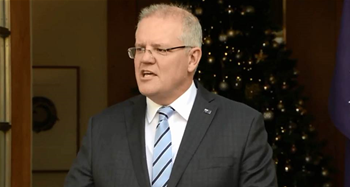The Department of Communications and the Arts will merge with the Department of Infrastructure, Transport, Cities and Regional Development in February 2020 to create a new super-department.
Prime Minister Scott Morrison revealed the changes on Thursday ahead of the release of David Thodey's long-awaited root-and-branch review of the Australian Public Service next week, a move that took many by surprise.
The new department, named the Department of Infrastructure, Transport, Regional Development and Communications, will be one of four new departments to be established on 1 February 2020.
It is the first change to the composition of the current Communications department since it was created in a September 2015 restructure brought by former PM Malcolm Turnbull, and effectively pushes communications policy down further down the government’s pecking order.
“This [change] will ensure, particularly in the area of communications, you’re getting a strong synergy between what’s happening with communications policies, communications infrastructure delivery and regional Australia,” Morrison said.
“I want to ensure the remote and regional parts of our country are connected. I want to ensure that our regional towns and communities are plugged in and are locked into the prosperity that can be achieved and will be achieved in our economy in the years to come.
“Infrastructure, communications; they are the same thing these days. They’re actually plugging people in and connecting them in, inclusively, into the benefits of a growing economy.”
Current Communications department sectary Mike Mrdak, who has held the position since September 2017, will leave his role as part of the Machinery of Government (MoG) changes.
He will effectively be replaced by current Infrastructure department secretary Simon Atkinson, who was appointed to the role last month.
In an email to staff, Mrdak said the department was not consulted on the restructure and was only notified of the changes less than 24 hours before Morrison's announcement.
"I was told of the government's decision to abolish the department late yesterday afternoon," the email states.
"We were not permitted any opportunity to provide advice on the Machinery of Government changes, nor were out views ever sought on any proposal to abolish the department or to changes to our structure and operations.
"At this time I understand that all of our functions, responsibilities, staff and programmes will transfer into the new department."
Other departments to be created in the shakeup are:
- The Department of Education, Skills and Employment, which brings together the current Department of Education and the Department of Employment, Skills, Small and Family Business.
- The Department Agriculture, Water and Environment, which consolidates the current Department of Agriculture and the environment functions from the Department of Environment and Energy.
- The Department of Industry, Science, Industry and Resecures, which merges the current Department of Industry, Innovation and Science and the energy functions from current the Department of Environment and Energy. Small Business functions will also move.
The new departments will reduce the total number of departments from 18 to 14, though this will not have any impact on the government’s ministry, announced after the May federal election.
Services Australia – essentially a rebadged version of the former Department of Human Services that was created following the May election – has also been demoted from a non-corporate Commonwealth entity to an executive agency.
“The Department known as Services Australia ... will be established as a new executive agency and this will all sit within the Social Services department,” Morrison said.
As a result of this change, current Services Australia secretary Renée Leon will be replaced by Department of Social Services secretary Kathryn Campbell.
“Australians should be able to access simple and reliable services, designed around their needs,” Morrison said.
“Having fewer departments will allow us to bust bureaucratic congestion, improve decision making and ultimately deliver better services for Australian people.”
Morrison wouldn’t detail whether any public servants would lose their jobs as a result of the restructure, though it is expected the changes at least some impact on staffing levels, particularly at a back office level.
Morrison said that any decision to reduce staff levels would be made by departmental secretaries.
“There is nothing in these changes that is a directive to secretaries to making any changes in those areas [job cuts],” he said.
“This has not been done as a savings measure. This has been done as a structural issue to better align and bring together functions within the public service, so they can all do their jobs more effectively and help more Australians.”


























